| |
|
|
| |
A taste of things to come. { fishing the cicada }
Thu 17th January, 2013
|
|
|
|
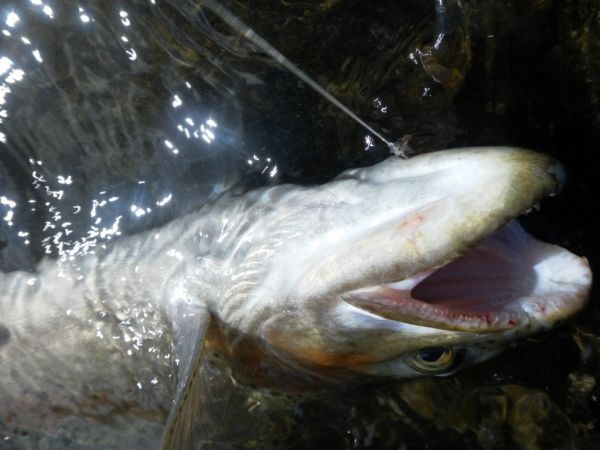
Its been another good week on the Tongariro. With the Christmas break over for another year angler numbers have dropped right back again. At times the river seemed almost deserted and most of the anglers I met were from overseas. During the seven days I spoke with fisho's from California, Sweden, Italy, Oz and the U.K and as usual although first time visitors to New Zealand were finding it hard most of them had caught fish. The majority of these were kelts but with a a lot of the earlier spawners already well recovered they were providing excellent sport both on the nymph and if conditions allowed during the evening rises. Anglers fishing just below the road bridge seemed to be doing ok either early morning or late afternoon into evening. And every time I watched someone fishing there at those times they'd eventually hook up. Daytime hatches are still short-lived affairs and the few better fish I've seen rising have been in the middle river pools. Where ever you fish at the moment there's a good chance your fly will probably get grabbed by a six inch juvenile. Handle these little fellas carefully because they won't stay little for long. The brown trout fishing is still a bit slow and at present there seem to be noticeably less browns around than in previous years. There are a number of places along the Tongariro where you would have expected to find a few big fish by now but so far I haven't come across any. If you haven't read it, below is Dave Lumley's December 2012 summary of the Waipa Trap Data taken from the D.O.C web-site : 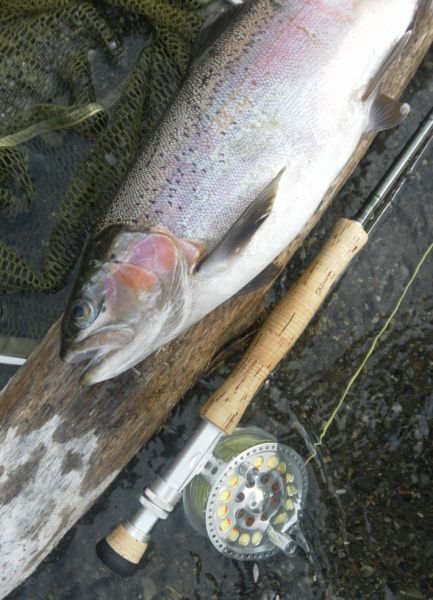
"Close to 150 rainbow trout were trapped in the Waipa Stream fish trap (a tributary of the Tongariro River near Rangipo) during the first 10 days of December and these fish averaged 466 mm and 1.2 kg with an overall condition factor of 43. The heaviest fish trapped this month was a maiden hen measuring 520mm and weighing in at 1.95 kg (4.3 lbs) with a condition factor of 50.
The condition of the fish running upstream to spawn has certainly been an improvement over last year even at this late stage of the spawning run.
Based on some early calculations, the run of rainbow trout through the Waipa Stream fish trap reached 2,742 fish for the period April through to mid December 2012. This is the highest run of rainbow trout in this stream since 2008 when the count was at 3,100 rainbows.
Overall, rainbows trapped during 2012 have averaged 466 mm and 1.2 kg whilst browns have averaged 581 mm and 2.45 kg (5.4 lbs).
Over 500 spent fish or kelts were also trapped during early December as these fish head back downstream to recover in the Tongariro and Lake Taupo over the summer months ".
 On Tuesday I fished with Jon and Amanda from Newcastle in N.S.W who had recently got married and were on their honeymoon. As Amanda pointed out her new husband must have been saying his prayers the night before they met because he's been lucky enough to marry a girl who shares his passion for fly fishing. Unfortunately for Jon that's where his luck ended because it turns out she's better at it than he is. Although he hooked and played a cracker of a fish just before lunch, he lost it when it threw the hook just as he began to regain some line. It was a close call but at the end of the session it was Amanda who ended up with the biggest fish of their day on the Tongariro. Jon has his own web-site and once they get back home you'll probably be able to read all about his New Zealand fishing trip ... sorry honeymoon. Check it out at : www.thetroutjournals.com
On Tuesday I fished with Jon and Amanda from Newcastle in N.S.W who had recently got married and were on their honeymoon. As Amanda pointed out her new husband must have been saying his prayers the night before they met because he's been lucky enough to marry a girl who shares his passion for fly fishing. Unfortunately for Jon that's where his luck ended because it turns out she's better at it than he is. Although he hooked and played a cracker of a fish just before lunch, he lost it when it threw the hook just as he began to regain some line. It was a close call but at the end of the session it was Amanda who ended up with the biggest fish of their day on the Tongariro. Jon has his own web-site and once they get back home you'll probably be able to read all about his New Zealand fishing trip ... sorry honeymoon. Check it out at : www.thetroutjournals.com
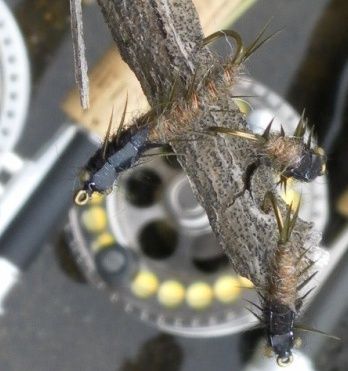 I began the week fishing with small naturals but some of the fish were taking the bomb again, so I tried a few of the bigger nymphs in my box including the " toe-biter " which we did a piece on last year. Its not a fly I use all of the time but is worth a shot occasionally. This larvae of the Dobson fly has a pretty lengthy nymphal stage... two years or more and although I haven't found any recently they're in the river {somewhere} all year round. In fact the fish that Jon lost was hooked just after I'd tied one on for him and the trout above Amanda's head picked one up earlier this trip. The rest of the time a plain old Hare and Copper was as good as anything.
I began the week fishing with small naturals but some of the fish were taking the bomb again, so I tried a few of the bigger nymphs in my box including the " toe-biter " which we did a piece on last year. Its not a fly I use all of the time but is worth a shot occasionally. This larvae of the Dobson fly has a pretty lengthy nymphal stage... two years or more and although I haven't found any recently they're in the river {somewhere} all year round. In fact the fish that Jon lost was hooked just after I'd tied one on for him and the trout above Amanda's head picked one up earlier this trip. The rest of the time a plain old Hare and Copper was as good as anything.
You may remember about 18 months ago we followed the fly fishing adventures of Tasmanian angler Paul Anderson. He's on the river again for the next fortnight. Paul fishes all over the world but has a soft spot for the Taupo fishery and particularly the Tongariro river. Well, after this trip he's already planning another marathon journey ... Mongolia ... watch this space.
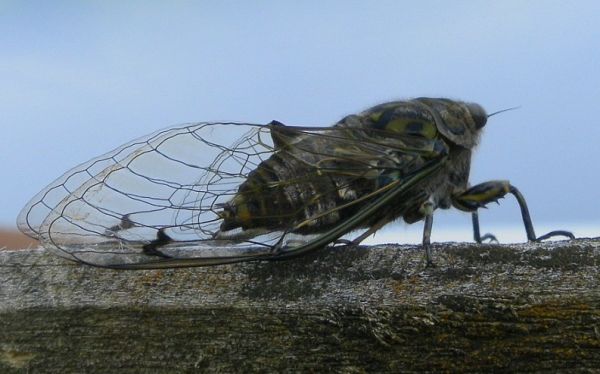
FISHING THE CICADA
Anglers are still waiting for the emergence of cicadas along the river. Although noise levels are slowly increasing the unsettled cooler weather is preventing the appearance of large numbers of these big terrestrials. What triggers the nymphs to leave their burrows is still a bit of a mystery. But studies suggest that ground temperature plays a part and to really get things moving it has to be around 18 degrees centigrade so we need the warm settled spell that's forecast. There is already plenty of information about their life cycle etc., dotted about the site but for those of you who aren't regular visitors I'll repeat some of it here ... the rest of you stop yawning.
Trout love these impressive insects and when enough of them " end up in the drink " they'll quickly switch from their main diet of caddis and mayfly and focus on the cicada. To a trout its a lot of food for comparatively little effort. Just just think about the difference in size between a mayfly nymph or caddis larvae and a single cicada. Thats a lot more calories in one hit ... no wonder they gorge on them.
Its impossible to predict how good or bad the cicada fishing on the Tongariro is likely to be. But if you are lucky enough to be here during a good year you're in for some truly awesome sport. If you've never tried fishing a dry fly you won't get a better time to learn, especially when the trout first become interested in these big bugs.
Cicadas are not found naturally "in" the river. In other words they don't intentionally have an aquatic stage in their life cycle as does a mayfly or caddis. Just like other terrestrials they end up in the river by accident, so anywhere there is over hanging foliage and trees is a great place to fish cicada imitations. Before the clearance work downriver the T.L.B of Reed was just one of many well known spots where you were able to catch fish close to the bank feeding on cicadas and later passion vine hoppers.
Don't worry too much about a delicate delivery. I'm not suggesting that you can thrash the river to a foam but as long as you achieve a reasonable cast there's no need to panic if your fly " alights " like a marble. Cicada's have been around for a long time but they still haven't quite got the hang of flying and trout are well used to them falling into the river with a plop! Its likely this sound is probably one of the triggers that alerts them to the fact that another year has passed and these large insects are once again on the menu. 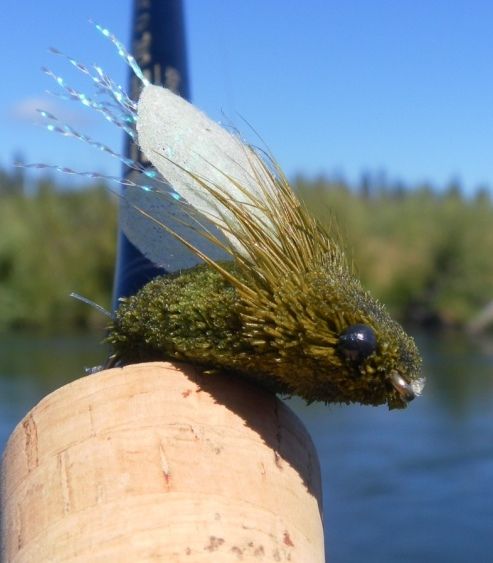
There are several good commercially tied patterns available in the local tackle shops. One of the most popular and durable is made of dyed deer hair which has been cut to shape and with the addition of eyes, wings and a little bit of sparkle does a pretty good job of representing the real thing. I find these work best at the start of the cicada season as the fish first " tune into them ". During this period the takes can seem almost suicidal and they'll hit the flies hard. But as more and more anglers begin using them they seem to get a bit suspicious and bored with them and the deer-hair version becomes much less effective.
Luckily by the time that happens they should be really switched on to taking big surface flies. With plenty of patterns to choose from just change to one of the more bizarre rubber leg creations which are tied in all sorts of colors using foam and other materials. If you continue to get fish coming for the fly that turn away at the last second then this is a good time to experiment with a dropper off the bend and tie on a nymph or even a wee wet. Trout will often grab this if they've refused the big dry.
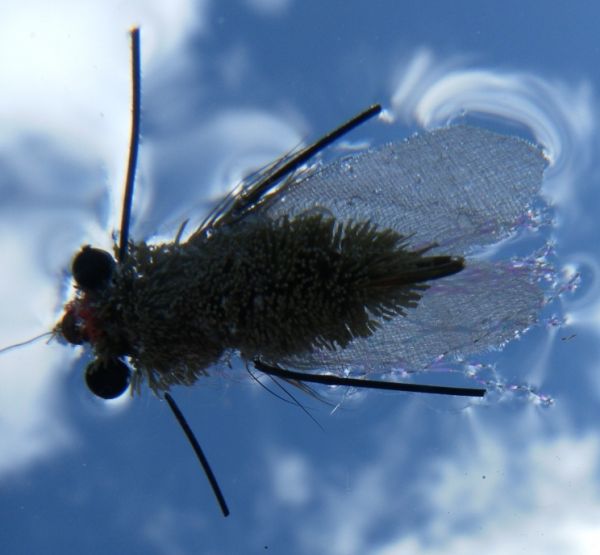
When trout become preoccupied with these large terrestrials they're one of the few food items they'll move any distance for. Try drifting one along the feed lanes in a pool, occasionally giving it a couple of twitches as it travels downstream. Even if there aren't any signs of trout feeding the sight of a big juicy cicada apparently struggling on the surface will often tempt them up from the depths.
The deer hair version with or without rubber legs makes a great indicator and will hold up a couple of nymphs. But despite their size they're notoriously difficult to spot in broken water or poor light conditions so its best to tweak them. You can easily do this by tying in either a white or fluorescent orange tag behind the eyes. Trout can't see the tag from below and this small alteration to the fly makes a huge difference as you track it throughout the drift. 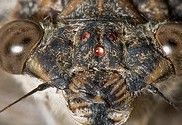
Talking of eyes did you know cicadas have five of them. The obvious large compound eyes either side of their heads and if you look closely there are three much smaller ones in between. After a bit of " googling " I discovered these are called ocelli from the Latin word oculus { eye } and means " little eye ". They're used mainly to detect changes in light and probably help the cicada hightail it if attacked by predators.
Here I go, off on a tangent again. Where was I? Oh yeah ... I keep my cicada imitations in a sealed plastic container and spray the whole lot with Selley's well before I'm going to use them. The trout don't seem to mind the stuff and it allows the product to cure properly ensuring they float high and dry for much longer.
Normally about this time in the report we have " this weeks fishy quote " but for the next few weeks its all change. I love Irish jokes and Grant Insley sent me a heap of them ...here goes :
Bloke at a horse race whispers to Paddy next to him, "do you want the winner of the next race?"
Paddy replies "No, tanks. I've only got a small garden."
Paddy and Mick found 3 hand grenades and decided to take them to the police station.
Mick "What if one explodes before we get there?"
Paddy: "We'll lie and say we only found two!"
A coachload of Paddies on a mystery tour decided to run a sweepstake to guess where they were going..... the driver won $112 dollars!
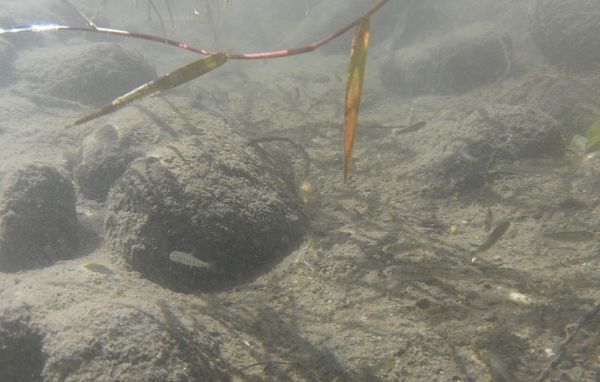 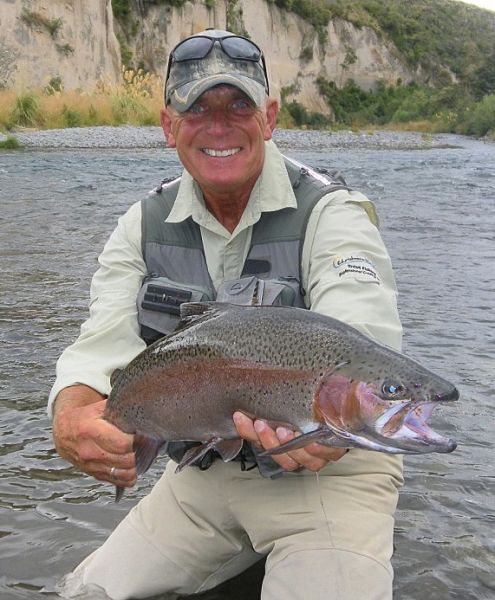
Every where you go on the river you'll see fry in the margins. But most of them will never make it to adult-hood because of predation, floods etc.
If I remember rightly out of every thousand eggs that a female rainbow lays only one or two will survive to become a mature trout. But there does seem to be a lot more fry in the river this year so it'll be interesting to see what effect this will have a few years from now.
There are also plenty of juveniles around especially in the riffles and tail-outs. I recall 2009/10 they seemed to be everywhere and hung around forever. In some places it was almost impossible to hook anything bigger because they were on the fly straight away.
Those " pocket rockets " were a pain at the time but we all knew they represented the future of the fishery and as always they were handled and released with care. Now a few years later we're beginning to see the rewards.
Long may it continue.
Have a great week guys.
Mike. |
|
|
| Back to Top |
|
|
|
|
|
|
|